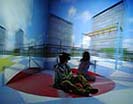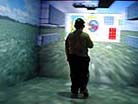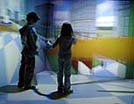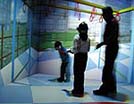The results of the evaluation were analysed by using multiple methods, both qualitative and quantitative.
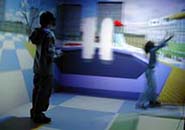 The qualitative method of analysis was based on supporting or refuting emerging hypotheses; we reviewed the video of all sessions and identified various points where interesting interactions seemed to occur (Barab et al., 1999). We then proposed hypotheses concerning the interactions observed, explaining these in terms of learning. We focussed on points where participants made a statement that indicated they have changed their belief or where we could draw conclusions from our observation of the participant’s behaviour in the environment. The collected data were analysed using an Activity Theory framework (Nardi, 1996). Activity Theory provides us with the conceptual vocabulary to help interpret these points qualitatively and to identify conceptual contradictions, i.e. the occurrence
of critical incidents, focus shifts or breaks in the elements of the learner’s activity that led to indications The qualitative method of analysis was based on supporting or refuting emerging hypotheses; we reviewed the video of all sessions and identified various points where interesting interactions seemed to occur (Barab et al., 1999). We then proposed hypotheses concerning the interactions observed, explaining these in terms of learning. We focussed on points where participants made a statement that indicated they have changed their belief or where we could draw conclusions from our observation of the participant’s behaviour in the environment. The collected data were analysed using an Activity Theory framework (Nardi, 1996). Activity Theory provides us with the conceptual vocabulary to help interpret these points qualitatively and to identify conceptual contradictions, i.e. the occurrence
of critical incidents, focus shifts or breaks in the elements of the learner’s activity that led to indications
of the learner’s construction of meaning. All participants mentioned during the analysis are pseudo-anonymised.
In this process, a number of interesting observations were made on a conceptual level and various themes emerged. One of the themes that emerged from the study concerned the difficulty that children have when asked to compare fractions. This was a consistent problem across most participants.
|
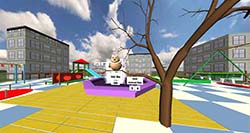 The results indicate that activity based on the cues or feedback provided by the VE led participants
to complete the tasks successfully in the interactive VR condition compared to the non-VR condition.
Interactivity aided in promoting skill and problem solving and provided opportunities for contradictions
to emerge. However, interactivity did not necessarily lead to resolution of these contradictions nor did
it ensure that, if resolution was made, this was at the conceptual level. On the other hand, the passive
VR form of experience, where the tasks were performed by a virtual robot observed throughout by
the participant, showed the potential to support resolution of contradictions in a way that encouraged
reflection of the underlying conceptual learning problems. This guided form of interaction, rather than
the fully interactive condition, provided evidence of sustained conceptual change. The results indicate that activity based on the cues or feedback provided by the VE led participants
to complete the tasks successfully in the interactive VR condition compared to the non-VR condition.
Interactivity aided in promoting skill and problem solving and provided opportunities for contradictions
to emerge. However, interactivity did not necessarily lead to resolution of these contradictions nor did
it ensure that, if resolution was made, this was at the conceptual level. On the other hand, the passive
VR form of experience, where the tasks were performed by a virtual robot observed throughout by
the participant, showed the potential to support resolution of contradictions in a way that encouraged
reflection of the underlying conceptual learning problems. This guided form of interaction, rather than
the fully interactive condition, provided evidence of sustained conceptual change.
More information about the study results can be found in the published papers. |

